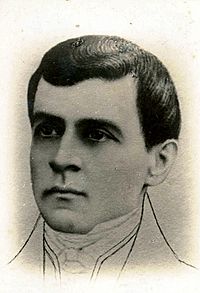Fernando Serrano facts for kids
Quick facts for kids
Manuel Fernando Serrano Uribe
|
|
|---|---|
 |
|
| President of the United Provinces of the New Granada | |
| In office July 16, 1816 – September 16, 1816 |
|
| Preceded by | Custodio García Rovira |
| Succeeded by | Abolished |
| Personal details | |
| Born | May 30, 1789 Cácota de Matanza, Viceroyalty of the New Granada |
| Died | February 15, 1819 (aged 29) Ciudad Guayana, Captaincy General of Venezuela |
| Spouse | Rosa Calderón Estrada |
Manuel Fernando Serrano Uribe (born May 30, 1789 – died February 15, 1819) was an important leader from New Granada (which is now Colombia). He was a lawyer and an officer in the army.
He served as the Governor of the Province of Pamplona and even wrote its constitution in 1815. He was also the last president of the United Provinces of the New Granada. This was a country that existed before the Spanish took control again in a period called the Reconquista.
Contents
Early Life and Education
Manuel Serrano was born on May 30, 1789, in Cácota de Matanza. His parents were Pedro Javier Serrano y Durán and Antonia de Uribe y Mantilla. His family was well-known in the area of Girón, Santander.
Manuel grew up in Girón and Piedecuesta, where his family owned a business. He went to study law at the Our Lady of the Rosary University in Santafé de Bogotá. After finishing his studies, he returned to Pamplona. There, he met Rosa Calderón Estrada, who came from a rich family. They fell in love and got married.
Becoming Governor of Pamplona
Manuel Serrano joined the movement for independence from Spain. On July 4, 1810, the independence forces took control of the Province of Girón. This province then joined the Province of Pamplona. Pamplona included areas like Cúcuta, Salazar, and Bucaramanga.
Serrano was chosen to be the Speaker of the Supreme Junta, which was a ruling council. This was his first public job. When the Junta ended, he joined the Republican Army. This army fought against the Royalist Army, which supported the Spanish King.
In 1812, Serrano became a Commander in the army. He fought in the siege of Mensulí, near what is now Floridablanca. His success helped the Republicans gain control of Girón and Bucaramanga.
Later, the governor of Pamplona stepped down. Manuel Serrano was chosen to take his place. He became the third governor of the new province. In 1815, Serrano helped create a new constitution for Pamplona. This constitution was very modern for its time. It even called for the end of slavery.
Spanish Takeover
In November 1815, Spanish forces invaded Pamplona from Venezuela. Serrano’s army was not strong enough to stop them, even with help from other leaders. Serrano had to leave Pamplona quickly. He sold his belongings and left his family behind to join the army and keep fighting for the country.
His wife, Rosa Calderón Estrada, and their four young children had to flee. They went to Bogotá, hoping to find safety with a cousin. But Rosa was recognized, captured, and put in prison.
Serving as President
After the previous president, Custodio García Rovira, was captured in July 1816, the country had no leader. This made the independence fighters confused and weak. General Manuel Valdez gathered the leaders of the resistance in Arauca.
On July 16, they chose Serrano as the new president. They picked him because he was educated and brave. Francisco de Paula Santander was chosen as the main general of the armies.
Serrano’s time as president was short, lasting only two months. Most of the country was taken over by the Spanish. On September 16, 1816, General José Antonio Páez from the Venezuelan army arrived. He took control of the remaining armies. The role of president was no longer needed because there was no country left to lead.
Serrano understood the situation and was not upset. He continued to fight alongside Páez. Years later, Páez wrote in his memories about Serrano’s bravery and service.
Fighting for Final Independence
Serrano kept serving in the army. In 1819, Simón Bolívar won a big victory against the Spanish. Serrano was asked to join the Congress of Angostura as a representative. This was a very important meeting to plan the future of the new independent countries.
Serrano was badly wounded, but he agreed to go. He traveled to Ciudad Bolívar. Sadly, his health was very poor. He died from his wounds on February 15, 1819, in Ciudad Guayana. He was only 29 years old.
See also
 In Spanish: Fernando Serrano Uribe para niños
In Spanish: Fernando Serrano Uribe para niños

